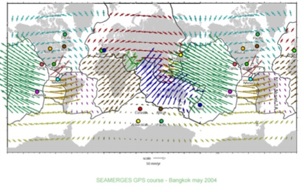A unique small UAS is on the horizon—the Triumph F1from Javad GNSS. Its eight propellers are powered by four lithium polymer batteries in a stacked quad configuration. It has four angled cameras and one downward facing camera for photogrammetry with a 60 degree field of view. It is equipped with a SIM card slot, Wi-Fi, two micro-SD slots for recording images, and a USB connector for downloading collected images and uploading flight plans generated by the mission programming available with the vehicle. There are landing and sonar sensors. The four landing pillars are integrated with communication antennas. The built-in indicators report on satellite tracking, communications, flight status and the gyro. Its typical range is 10km by 10km.
The main selling point of the UAS is the Javad Triumph 1 geodetic GNSS receiver, which is based on the Triumph chip. It can track all existing and planned satellite navigation constellations including GPS, GLONASS, Galileo, QZSS, WAAS, EGNOS, and BeiDou. The receiver on the Triumph F1 has 864 channels available. It also has anti- jamming filters in five different bands that can suppress interference to 60 dB. The advantages are an increased number of satellites and signals, better satellite availability, better dilution of precision, immediate ambiguity resolution, better accuracy in urban settings, and fewer multipath worries. Further, the receiver at the center of the UAS can be removed from the four detachable arms attached to a pole for field use as a base or rover using the four screw inserts at the bottom.






